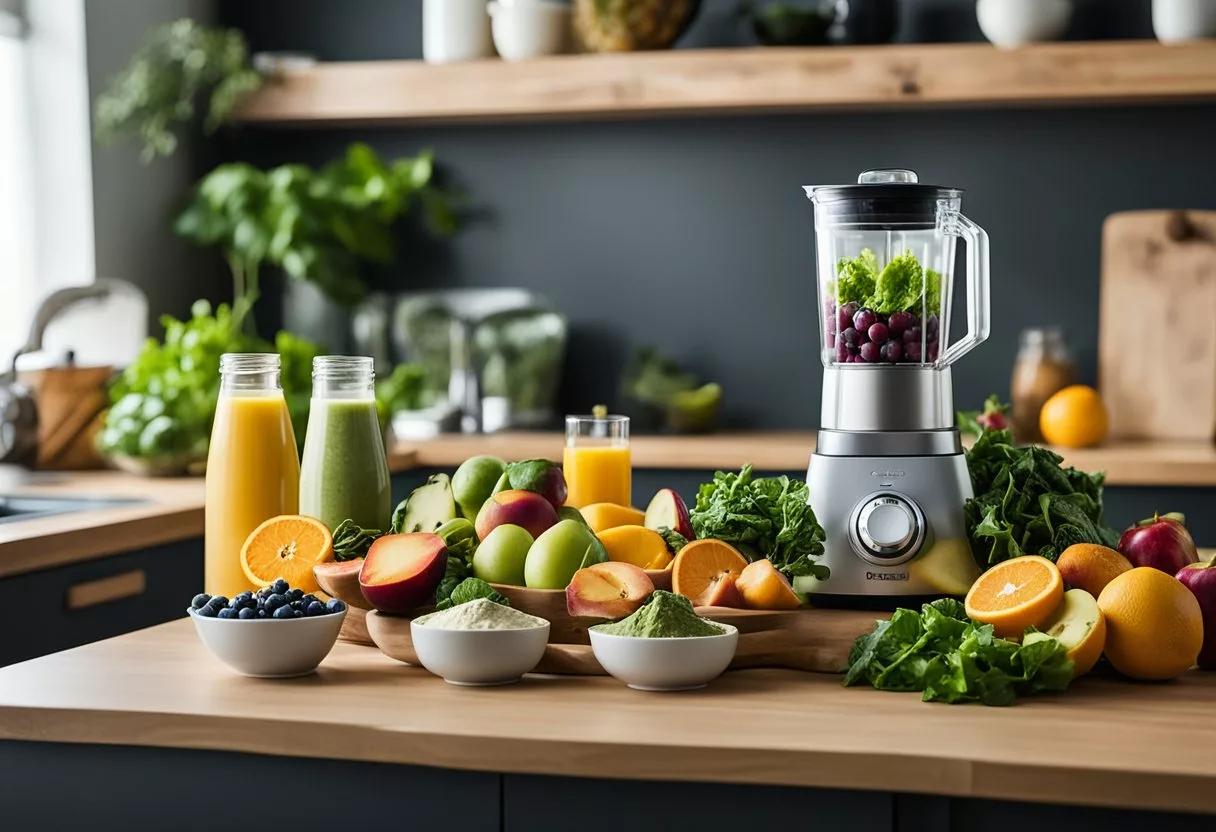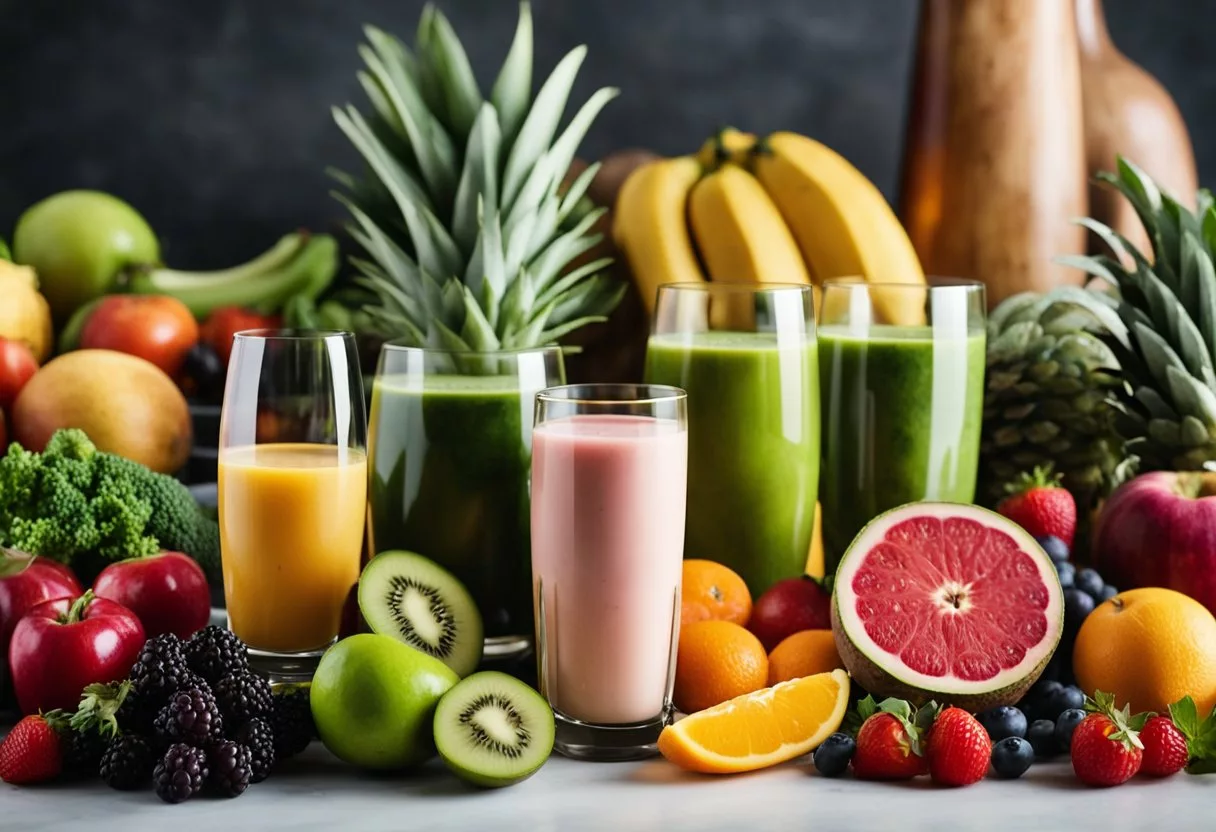Smoothies and shakes are foundational staples in the ketogenic, or keto, diet. This low-carb, high-fat dietary regimen aims to induce a state of ketosis, where the body primarily burns fat for energy.
Typically, smoothies are high in carbohydrates due to the natural sugars present in fruits. However, with the correct blend of low-carb fruits, healthy fats, and proteins, they can fit seamlessly into the keto lifestyle.

Creating a keto-friendly smoothie or shake involves careful selection of ingredients to maintain the delicate balance required for ketosis. Ingredients such as avocado, low-carb berries, nut butters, seeds, and healthy oils can be combined with keto-specific supplements to provide both flavor and nutritional support without disrupting the metabolic state.
These drinks can be crafted to cater to those seeking to adhere to their keto macros while enjoying a quick, nutritious meal replacement or snack.
Understanding Keto

The ketogenic, or keto, diet is a nutrition plan focused on high-fat, low-carbohydrate intake to encourage the body to enter a state of ketosis. This section lays out the critical elements for anyone seeking to integrate keto smoothies and shakes into their diet.
Foundations of Ketosis and Keto Diet
The keto diet hinges on the metabolic state of ketosis, where the body burns fat for energy instead of carbs. This shift occurs when carbohydrate intake is significantly reduced to about 20-50 grams per day, prompting the liver to convert fat into ketones for fuel.
Benefits of Keto Smoothies and Shakes
Keto smoothies and shakes offer convenient avenues to ingest essential nutrients while adhering to the keto paradigm. They can be tailored for weight loss, enhanced mental clarity, increased energy levels, and improved insulin sensitivity.
Key Ingredients for Keto Smoothies
Ideal smoothie constituents favor healthy fats and low net carbs. Utilize ingredients like:
- Avocado: Rich in monounsaturated fats
- Coconut: Provides medium-chain triglycerides (MCTs)
- Seeds and nut butter: Include flaxseeds, chia seeds, and almond butter for fiber and protein.
Avoiding Common Pitfalls
Avoiding high-carb fruits and sweeteners is essential. Even ingredients like milk can be too carb-dense, so options like almond milk are preferable. Sweeten with stevia or erythritol instead of sugar.
Assessing Macros and Net Carbs
It’s vital to calculate macros and net carbs (total carbs minus fiber) to ensure you’re within keto limits. For instance:
| Ingredient | Net Carbs (g) |
|---|---|
| Almond milk | 1-2 per cup |
| Avocado | 2 per 100g |
Customization and Variety
Infusing a variety of flavors and textures keeps your palate interested. Incorporate different vegetables, greens, and flavorings like cocoa or vanilla extract to diversify your smoothies without increasing carbs.
Adapting Keto Smoothies for Other Diets
Keto smoothies can be adapted for other dietary needs, such as paleo or vegan, by swapping out or omitting certain ingredients like dairy protein powder for plant-based alternatives or ensuring all ingredients are paleo-compliant.
Essential Ingredients

Selecting the right ingredients is crucial for creating keto-friendly smoothies and shakes that are both nutritious and tasty. This section outlines the elements necessary for crafting delicious low-carb beverages.
Fats and Dairy Alternatives
Keto smoothies prioritize high-fat ingredients. Avocado and coconut cream provide a rich texture and healthy fats. Alternatives to dairy can include nut butters such as almond or peanut butter for a creamy consistency and added flavors. MCT oil and seeds like chia or flax offer an extra boost of essential fats.
Proteins and Supplements
Adding protein powder, such as whey or collagen, can increase the nutritional value of keto shakes. Proteins are vital for muscle repair and can help keep you full longer. Collagen powder supports skin and joint health.
Fruits and Vegetables
Low-carb berries like strawberries, blueberries, blackberries, and raspberries are excellent for adding natural sweetness and antioxidants. Spinach and kale are nutrient-dense vegetable options that mix well without overpowering other flavors.
Liquids and Milk Substitutes
The liquid base of your smoothie is important for consistency. Almond milk and coconut milk are popular keto-friendly choices. They are lower in carbs than traditional dairy milk and enhance the beverage’s creaminess.
Natural Sweeteners and Flavors
Refined sugars are a no-go on a keto diet. Sweeten your smoothies with natural alternatives like erythritol, stevia, or monk fruit. Enhance the flavor profile with a dash of vanilla extract, cocoa powder, or spices such as cinnamon, turmeric, and ginger.
Recipe Construction

When creating keto-friendly smoothies, one should focus on balancing flavors while maintaining low net carbs and high fat content to adhere to the ketogenic diet’s requirements.
Basic Keto Smoothie Formula
A keto smoothie’s foundation rests predominantly on selecting ingredients that keep net carbs low and fats high. One should consider the following components for their formula:
- Liquids (1 cup): Choose high-fat liquids like almond milk or coconut milk.
- Fats (1-2 tablespoons): Incorporate sources like avocado, coconut cream, or nut butter.
- Proteins: Add a scoop of low-carb protein powder or collagen.
- Low-Carb Vegetables/Fruits: Typically berries, as they are lower in net carbs.
Crafting Creamy Textures
The hallmark of a satisfying smoothie is its creaminess. Achieving this without high-carb dairy products is key for a keto smoothie:
- Avocado: Offers smoothness while contributing healthy fats.
- Greek Yogurt: Use full-fat, unsweetened variety sparingly.
- Nut Butter: Almond or cashew butter can enrich the texture.
- Seeds: Chia or flax seeds thicken the smoothie while adding fiber.
Adding Superfoods and Boosters
To amplify the nutritional value of keto smoothies, consider adding:
- Greens: Spinach or kale can be incorporated for a keto green smoothie.
- Seeds: Chia or flax seeds increase fiber content.
- Matcha: A rich source of antioxidants.
- Spirulina: A nutrient-dense superfood.
The inclusion of these superfoods should be measured to avoid excess carb intake.
Keto Meal Replacement Shakes
For those seeking a full meal substitute in their keto regimen, a well-crafted shake can double as breakfast or dinner:
- Proteins and Fats: Ensure adequate protein and fat for satiety.
- Fiber: Add fiber sources to support digestion and fullness.
- Calories: Adjust portions to meet caloric needs of a full meal without overconsuming carbs.
By understanding these key principles, one can construct a variety of keto smoothie recipes that are nutritious and aligned with the ketogenic diet.
Frequently Asked Questions

This section aims to address common inquiries on crafting keto-friendly smoothies and shakes, ensuring they align with low-carb dietary requirements while still providing delicious flavors and adequate nutrition.
What are ideal ingredients to use in a keto-friendly post-workout shake?
Ideal ingredients for a keto post-workout shake include low-carb protein sources such as whey or plant-based protein powders, healthy fats like MCT oil or avocado, and water or unsweetened almond milk as a liquid base. These provide the necessary nutrients to support muscle recovery without adding excess carbs.
Which fruits can be included in a keto smoothie without increasing the carb count significantly?
Berries such as strawberries, blueberries, and raspberries are suitable for a keto smoothie because they are lower in carbs compared to most fruits. They also offer high fiber content which is beneficial for maintaining a low net carb intake.
How can I make a keto smoothie if I’m aiming for rapid weight loss?
For rapid weight loss on keto, a smoothie should be high in healthy fats, moderate in protein, and very low in carbohydrates. Include ingredients like spinach, kale, cucumber, and avocado for volume and nutrients without the carbs. It’s vital to monitor the portion sizes of all ingredients to maintain a caloric deficit.
Can you provide some breakfast keto smoothie recipes that are easy to prepare?
A simple keto breakfast smoothie could include unsweetened almond milk, a handful of spinach, protein powder, and a tablespoon of almond butter. Blend these together for a quick and nourishing start to the day. For variety, one can rotate the leafy greens and nut butters.
What are some methods to thicken keto smoothies without adding extra carbs?
To thicken a keto smoothie without extra carbs, use ingredients like xanthan gum, chia seeds, or avocado. These also contribute additional nutrients to the smoothie. Chia seeds, for example, provide fiber which can aid in digestion.
Is unsweetened almond milk a suitable liquid base for keto smoothie recipes, and why?
Unsweetened almond milk is an excellent liquid base for keto smoothie recipes because it is low in carbohydrates and calories. It also has a mild flavor that melds well with other ingredients and does not overpower the taste of the smoothie.